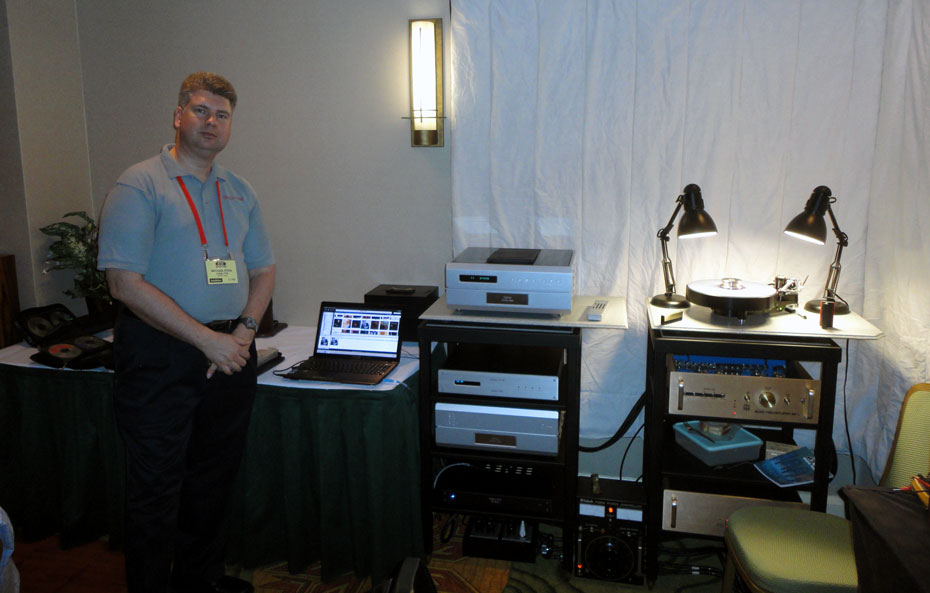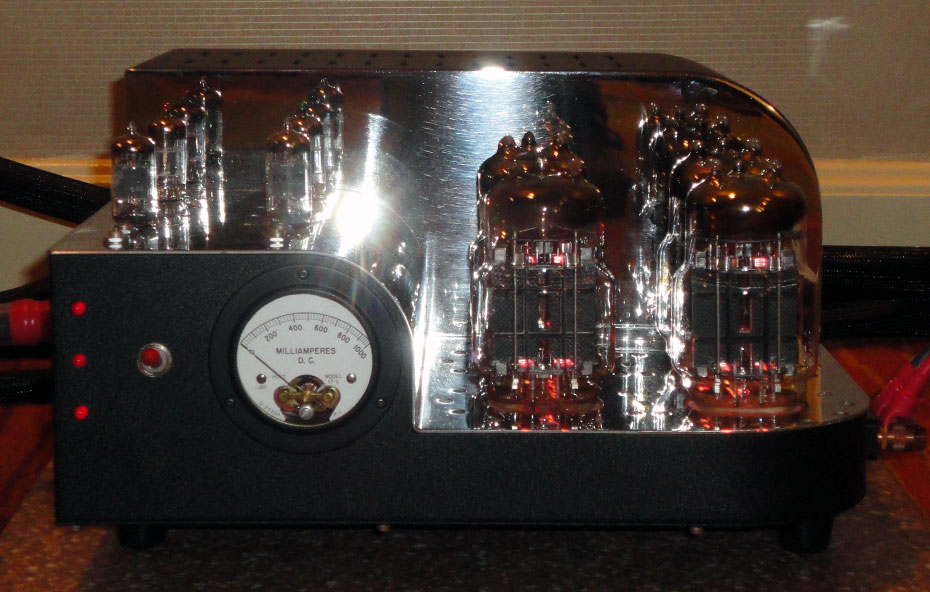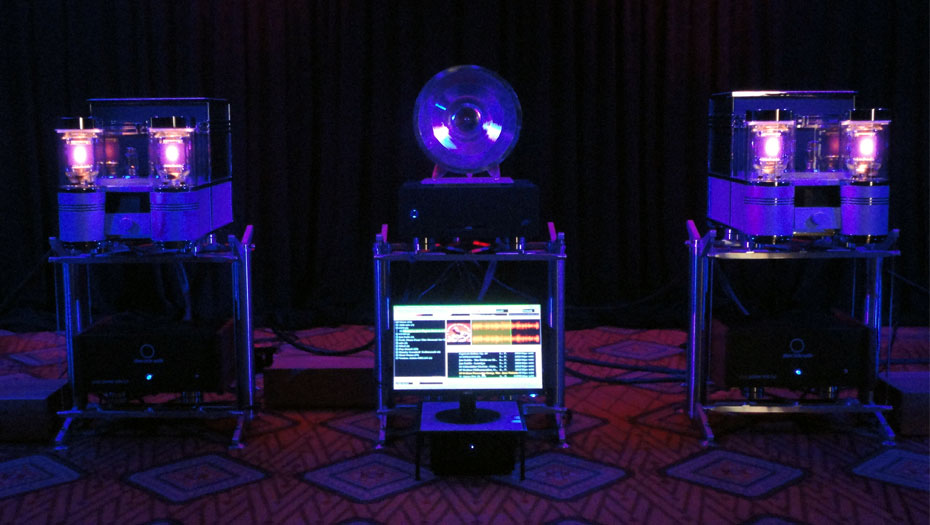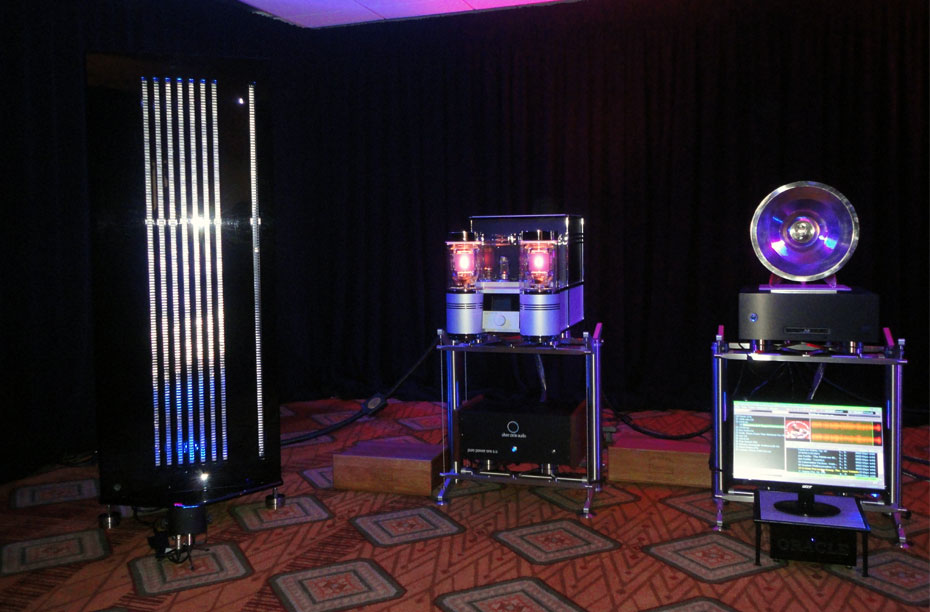As a summary of the Rocky Mountain Audio Fest this year, I will take you on a sweeping (as in quick, not comprehensive) tour of the show with the interesting experiences in systems I had day by day. You will see the good, the bad and the unusual. The show seemed thinner in attendance this year, I would presume due to the proliferation of regional shows over the past two or three years; a good thing for the industry, but a bad thing for any given show. Most manufacturers and attendees seemed in a good mood, as it seemed either the economic downturn had lifted somewhat, or we were all simply numb to it.
After a couple years of fairly stagnant big systems, some new setups yielded a fresh perspective. To break the monotony of it all, the Ayre Acoustics room time warped listeners back to the 50’s, and one exhibitor included skin care products for sale. That is fairly how this report will look, like my pinball tour of the hotel bouncing between demos, conversations, elevator rides and stair climbing.
Michael Stahl with Stahl-Tek front end
Classic Audio T-1.4 Reference Speaker with Atma Sphere Novacron Amplifiers
Novacron Amplifier
The first two systems I visited illustrated how wide the gulf is between technology and performance, two things which are not necessarily directly related. I have never been disappointed by the Classic Audio Speakers room, this year partnering with Atmasphere Music Systems, Purist Audio Design, Stahl-Tek LLC, Tri Planar, Eugene HiFi, and Van Den Hul. These manufacturers play near the very top with every setup at every show; the experience and refinement is unmistakable. This was a high efficiency speaker system with very large soundstage. Notable products was the return of the Atma Sphere Novacron Tube Amplifier ($12,000/pr) and MP-1 Preamplifier ($16,000 as outfitted at the show), and the Stahl-Tek front end featuring the A.B.C. (Audiophile Bridge to Computer) and Ariaa DAC.
Memory Player 64 Ultimate, 833TNT Monoblock Tube Amplifier, Leonardo Model 8 Riboon – Planar Speaker, Pure Power One 5.0 Power Conditioner
Memory Player, TNT Amps, Pure Power Conditioning and Novum Resonator
The second system I heard was less than spectacular, which should not have been the case for a $300k plus system. I was keen on hearing the Leonardo Model 8 Ribbon Planar Speaker ($65K/pr) led by the Memory Player 64 Ultimate ($27,950), and was impressed with the appearance of the Audio Power Labs 833TNT Monoblock Tube Amplifiers ($175K/pr), as well as the effort to provide funky lighting in the room. Under the show condition, I was not impressed by the system, which did not handle Philippe Saisse’s The Body and Soul Sessions disc very well.
There was definitely something amiss here; one problem was that the speakers were being played at what I consider far too high of a listening level for a small room and planar magnetic speakers. Evidence of that was found in the amps cutting out two times in a fifteen minute review due to protection circuitry. I assume the effort was being made to demonstrate the claimed 20Hz bottom end of the speaker, but the result was pretty rough, really loud, and really unrefined. At the level of the system, I assume the cymbal-like “highend Novum Premium PMR Version 2” Resonator was resonating up a storm, perhaps clanging like a bell. To be fair, this was very early on in the show, and by day three systems can be utterly transformed. I did not return to the room, so I do not know whether it was mended. I believe, individually, these components should have the capacity to sound far better, and perhaps utterly enchanting, but this was a tough demo.
This gives me the opportunity to discuss the difficult realities of show systems. Some components are finalized literally hours before a show, while some are still in development. Some are not finalized, yet all are being used. There is frenetic activity at many manufacturers the weeks leading up to shows. Exibitors may be traveling 1,000 miles or more and can be utterly exhausted while trying to set up their system. In transit, damage can be disastrous causing a partial or complete sidelining of the system. Last minute changes to partnerships and loaned equipment can alter a rig for the better or worse. Unexpected room issues for first time exhibitors, or a relocation can cause nightmares.
Were any of these in play in the case of the above system? Perhaps, and so I will leave open the possibility that next year these beautiful and passionately designed products will shine, perhaps with a rearrangement of components. Systems are as exquisitely individual as people, and if you catch a system sounding poor it does not absolutely mean the products are terrible. When you hear, “… it was a show system,” or similar, approach it with a bit more forgiving spirit than perhaps a visit to a local dealer who has had months, and perhaps years, to perfect the setup and execution of his systems.
- (Page 1 of 3)
- Next page →






Do you need a special av cable that is supropted by the iPod Touch 4g? I’ve seen many composite cables with the 30 pin connector but many say that they are for 1st or 2nd generation iPod only.